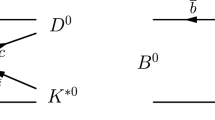Summary
The detection of partial muon capture rates in16O forms a sensitive detector for the induced pseudoscalar coupling constant. We here investigate the effects of nucleon velocity terms in the weak Hamiltonian and of realistic nuclear wave-functions. Their inclusion is essential for a correct treatment of the problem. In addition to the previously suggested detector level, we find that capture into the ground state of16N permits an almost complete elimination of nuclear physics by comparison to the β-decay rate.
Riassunto
La rivelazione dei rapporti parziali di cattura muonica nel16O costituisce un sensibile rivelatore per la costante di accoppiamento pseudoscalare indotto. Qui si studiano gli effetti sull’hamiltoniana debole dei termini contenenti la velocità del nucleone e delle funzioni d’onde nucleari realistiche. La loro inclusione è essenziale per una corretta trattazione del problema. In aggiunta al livello di rivelazione suggerito precedentemente, si trova che la cattura nello stato fondamentale del16N permette una eliminazione quasi completa della fisica nucleare in confronto al rapporto di decadimento β.
Similar content being viewed by others
References
V. S. Evseev, V. S. Roganov, V. A. Chernogorova, M. M. Szymezak andChang Run-Hwa:1962 International Conference on High-Energy Physics, CERN p. 425.
M. Conversi, R. Diebold andL. di Lella:International Conference on Fundamental Aspects of Weak Interactions (Brookhaven, 9–11 September, 1963).
H. P. C. Rood andH. A. Tolhoek:Phys. Lett.,6, 121 (1963)
I. S. Shapiro andL. D. Blokhintsev:Soviet Physics, J.E.T.P.,12, 775 (1961).
A. Fujii andH. Primakoff:Nuovo Cimento,12, 237 (1959).
J. R. Luyten, H. P. C. Rood andH. A. Tolhoek:Nucl. Phys.,41, 236 (1963);J. Delorme:Thesis, University of Lyon (1963).
J. P. Elliott andB. H. Flowers:Proc. Roy. Soc., A242, 57 (1957).
U. Meyer-Berkhout, K. W. Ford andA. E. S. Green:Ann. of Phys.,8, 119 (1959).
M. Eckhause:Thesis, Carnegie Institute of Technology, NYO 9286 (1962);J. Barlow, J. C. Sens, P. J. Duke andM. A. R. Kemp:Phys. Lett.,9, 84 (1964).
A similar calculation has been done in ref. (10). Our rate to the 1− state is 30% lower than found in this reference.
I. Duck:Nucl. Phys.,35, 27 (1962).
R. Cohen, S. Devons andA. D. Kanaris:Phys. Rev. Lett.,11, 134 (1963); corrected inNucl. Phys., to appear.
A. Astbury, L. Auerbach, D. Cutts, R. Esterling, D. Jenkins, N. Lipman, R. Shafer: UCRL-11115 (1964).
Author information
Authors and Affiliations
Additional information
This article supersedes an earlier preprint in which several errors have been corrected.
Rights and permissions
About this article
Cite this article
Ericson, T., Sens, J.C. & Rood, H.P.C. A detector for the induced pseudoscalar coupling constant. Nuovo Cim 34, 51–66 (1964). https://doi.org/10.1007/BF02725868
Received:
Published:
Issue Date:
DOI: https://doi.org/10.1007/BF02725868




